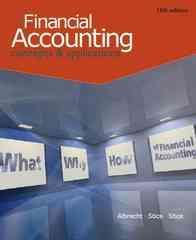Answered step by step
Verified Expert Solution
Question
1 Approved Answer
1. Alonzo Co. acquired 60% of Beazley Corp. by paying $240,000 cash. There is no active trading market for Beazley Corp. At the time of
1. Alonzo Co. acquired 60% of Beazley Corp. by paying $240,000 cash. There is no active trading market for Beazley Corp. At the time of the acquisition, the book value of Beazley's net assets was $300,000. Required: What amount should have been assigned to the non-controlling interest immediately after the combination? 2. Tosco Co. paid $540,000 for 80% of the stock of Martz Co. when the book value of Martz's net assets was $600,000. For all of Martz's assets and liabilities, book value and fair value were approximately equal. Required: Using the acquisition method, what amount of goodwill should appear in a consolidated balance sheet prepared immediately after the combination? 3. On January 1, 2011, Elva Corp. paid $750,000 for 80% of Fenton Co. when the book value of Fenton's net assets was $800,000. Fenton owned a building with a fair value of $150,000 and a book value of $120,000. Required: At what amount would the building appear on a consolidated balance sheet prepared immediately after the combination, under the acquisition method of accounting for business combinations? (for questions 4-5) On January 1, 2010, Glenville Co. acquired an 80% interest in Acron Corp. for $500,000. There is no active trading market for Acron's stock. The fair value of Acron's net assets was $600,000 and Glenville accounts for its interest using the acquisition method. 4. Determine the amount of goodwill to be recognized in this acquisition. 5. Determine the value assigned to the non-controlling interest as of the date of the acquisition. (for questions 6-8) Virginia Corp. owned all of the voting common stock of Stateside Co. Both companies use the perpetual inventory method, and Virginia decided to use the partial equity method to account for this investment. During 2010, Virginia made cash sales of $400,000 to Stateside. The gross profit rate was 30% of the selling price. By the end of 2010, Stateside had sold 75% of the goods to outside parties for $420,000 cash. 6. Prepare journal entries for Virginia and Stateside to record the sales/purchases during 2010. 7. Prepare the consolidation entries that should be made at the end of 2010. 8. Prepare any 2011 consolidation worksheet entries that would be required regarding the 2010 inventory transfer. (for questions 9-11) On January 1, 2011, Musial Corp. sold equipment to Matin Inc. (a whollyowned subsidiary) for $168,000 in cash. The equipment originally cost $140,000 but had a book value of only $98,000 when transferred. On that date, the equipment had a five-year remaining life. Depreciation expense was calculated using the straight-line method. Musial earned $308,000 in net income in 2011 (not including any investment income) while Matin reported $126,000. Assume there is no amortization related to the original investment. 9. What is consolidated net income for 2011? 10. Assuming that Musial owned only 90% of Matin, what is consolidated net income for 2009? 11. Prepare a schedule of consolidated net income and the share to controlling and noncontrolling interests for 2011, assuming that Musial owned only 90% of Matin and the equipment transfer had been upstream . 12. Fargus Corporation owned 51% of the voting common stock of Sanatee, Inc. The parent's interest was acquired several years ago on the date that the subsidiary was formed. Consequently, no goodwill or other allocation was recorded in connection with the acquisition price. On January 1, 2010, Sanatee sold $1,400,000 in ten-year bonds to the public at 108. The bonds pay a 10% interest rate every December 31. Fargus acquired 40% of these bonds on January 1, 2012, for 95% of the face value. Both companies utilized the straight-line method of amortization. What consolidation entry would be recorded in connection with these intra-entity bonds on December 31, 2012? (for questions 13-16) Thomas Inc. had the following stockholders' equity accounts as of January 1, 2011: Kuried Co. acquired all of the voting common stock of Thomas on January 1, 2011, for $20,656,000. The preferred stock remained in the hands of outside parties and had a fair value of $3,060,000. A database valued at $656,000 was recognized and amortized over five years. During 2011, Thomas reported earning $630,000 in net income and paid $504,000 in total cash dividends. Kuried used the equity method to account for this investment. 13. What is the amount of goodwill resulting from this acquisition? 14. What was the non-controlling interest's share of consolidated net income for the year 2011? 15. What is the controlling interest share of Thomas' net income for the year ended December 31, 2011? 16. What was Kuried's balance in the Investment in Thomas Inc. account as of December 31, 2011
Step by Step Solution
There are 3 Steps involved in it
Step: 1

Get Instant Access to Expert-Tailored Solutions
See step-by-step solutions with expert insights and AI powered tools for academic success
Step: 2

Step: 3

Ace Your Homework with AI
Get the answers you need in no time with our AI-driven, step-by-step assistance
Get Started


